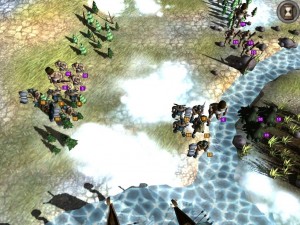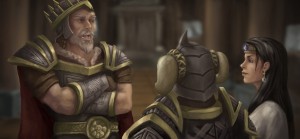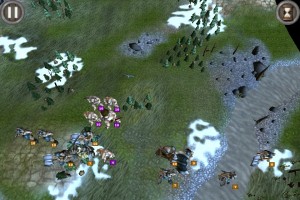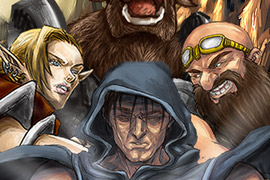 Let’s start out by getting to know the smuttlewerk team a little better. How do the team members divide the development and marketing work among yourselves, and did you all have backgrounds in the videogame industry before forming the studio? On that note, how did you all happen to meet up in the first place?
Let’s start out by getting to know the smuttlewerk team a little better. How do the team members divide the development and marketing work among yourselves, and did you all have backgrounds in the videogame industry before forming the studio? On that note, how did you all happen to meet up in the first place?
Ralph and myself, Martin, founded smuttlewerk interactive last year. We’ve known each other since we were ten years old (we’re 35 now) and we’ve lived only twenty meters apart since age sixteen! We “wasted” our youth together, playing games and making music and we always talked about doing our own games. We started developing a game for PC called “Titanomachy,” a turn-based, play by e-mail wargame in 2003. It nearly finished, but we stopped working on it when we founded smuttlewerk. Besides that, we had no experience in the videogame industry.
I started an apprenticeship in 2009 as “Game and Multimedia Designer” because my last work as landscape gardener literally broke my back. I can’t do heavy work anymore because of two slipped disks, and luckily I gained a place in the above mentioned apprenticeship class. There I met our new team members: Alex, Nikolai and Stephan. I quickly recognized the talent of these young fellows and talked them into joining the adventure of smuttlewerk interactive.
I guess our team is rather unusual. We have three programmers (Ralph, Alex and Stephan), one graphic artist (Nikolai) and me, the marketing-concept-level designer-story writer-teamleader guy. Nikolai did most of the graphics for Companions. It was his first job in this area and he did a wonderful job with it. Ralph is also our composer and musician.
 What’s the indie game development scene like in Germany these days? Does the smuttlewerk team see your studio as a pioneer, or as joining an already thriving movement within your country?
What’s the indie game development scene like in Germany these days? Does the smuttlewerk team see your studio as a pioneer, or as joining an already thriving movement within your country?
We are no pioneers, really. When it comes to iOS gaming, I don’t know many developers or studios, but I’m quite sure they exist. Take FISHLABS for example, they’ve been in mobile games since 2004.
The time was right to jump in and test our luck, I guess. The App Store is a dream come true for small indie studios. If you manage to produce quality apps you can make a living.
The projects smuttlewerk has created so far – Companions and the upcoming Time of Heroes – both take place in the land of Altland, right? Did anyone on the team spend a lot of time dreaming up the world before you formed smuttlewerk, or did world building begin when the team decided Companions would be your first project?
I started with the Altland concept when we began work on Companions. I have read quite a few books in my time, historical stuff mostly, since I studied history for almost five years, but also fantasy literature and sci-fi stories. I just started to mix real world history with fiction, and voila, Altland was formed. I like the idea of story evolution. I plan some things, but mostly I come up with stuff when it’s needed.
 Besides the shared setting in Companions and Time of Heroes, is there any other story overlap – characters, tribes, nations, etc.? Were there any questions planted in Companions that might be resolved in Time of Heroes, or vice versa?
Besides the shared setting in Companions and Time of Heroes, is there any other story overlap – characters, tribes, nations, etc.? Were there any questions planted in Companions that might be resolved in Time of Heroes, or vice versa?
Yes, you meet some characters who were mentioned (or even appeared) in Companions, like Oskar the iron golem. The story in Time of Heroes takes place 400 years before the happenings in Companions. The northern humans were just arriving in Altland in search of a new home. Soon they had to realize that they fled winter just to be thrown in a war that has raged in Altland for thousands of years.
The small things in Companions, the item descriptions for example, mention other characters, like the rogue elf Shoto Gar and his rogue dwarf friend Ung Bulmitz. You can find their weapons in Companions and you will face them in person in Time of Heroes.
It’s possible that we could do a follow up campaign for Time of Heroes, telling the story of how the northern tribes were transformed into minotaurs or the arrival of the southern humans in Altland. We will see.
 While Companions appears to have a strictly 2D presentation, you’ve obviously gone well into the third dimension with Time of Heroes. How challenging has that transition been – have the team’s artists spent way more time creating assets for this project, or did the programmers find models more difficult to work with than 2D assets?
While Companions appears to have a strictly 2D presentation, you’ve obviously gone well into the third dimension with Time of Heroes. How challenging has that transition been – have the team’s artists spent way more time creating assets for this project, or did the programmers find models more difficult to work with than 2D assets?
We developed Time of Heroes with Unity3D. Stephan did his graduation project with Unity, so it was only natural to choose the engine for our next game. We have a labor division: Stephan and Alex work with Unity and Ralph does the 2D stuff for Companions.
Nikolai, our artist, switches between 3D and 2D very fluently. The work on 3D models definitely takes more time though: textures, animations, modeling – quite a workload for one guy.


